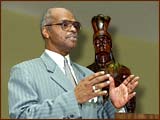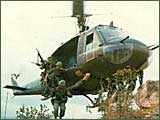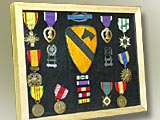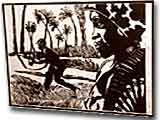AN AFRICAN AMERICAN'S VIETNAM WAR
Emotional Personal Account Marks Black History Month
By Hoag Levins
 | |
 Feb. 19, 2001
Feb. 19, 2001
CAMDEN, N.J. -- Even as they confronted the daily hardships common to all American troops in the Vietnam War, black soldiers were forced to grapple with additional burdens, Glenn L. Baker told an audience at the Camden County Historical Society yesterday.

Photo: Hoag Levins
|
| Glenn L. Baker at the Camden County Historical Society. Hear Baker
| "For instance, I remember how disturbing it was to come back from an operation to our base camp and see the Confederate flag being flown side by side with the American flag," explained the guest speaker at yesterday afternoon's "Black Soldiers in Vietnam" presentation.
The event in the Pomona Hall Museum and Library complex on the eastern edge of the city was the latest in a series of Society sessions celebrating Black History Month.
Two Purple Hearts
Baker, a job placement supervisor with the New Jersey Department of Labor in Camden, is a decorated, twice-wounded Army veteran. In 1969 he served with the 1st Air Cavalry Divison, Airmobile, in the central highlands and Cambodian-border areas of South Vietnam.
The 1st Air Cavalry played a leading role in the war. For instance, it pioneered the concept of infantry helicopter assault that became the standard American battle tactic. The unit's

Photo: U.S. Army
|
| The 1st Air Cavalry pioneered infantry helicopter assault techniques.
| primary vehicle -- the insect-shaped HUEY chopper -- ultimately became the very symbol of the war itself. The 1st Air Cavalry, which fought in the largest, most protracted, and bloodiest campaigns of the conflict, also suffered the highest rate of casualties of any U.S. military group in Vietnam.
Like many veterans, Baker came home from the war and resumed what appeared to be a normal life for fifteen years before experiencing the symptoms of Post Traumatic Stress Disorder (PTSD). He has undergone treatment at the Veterans Administration Medical Center in Coatesville, Pa., and describes himself as "a once-broken man who is on the mend -- I intend to continue fighting back, not flashing back."
Therapy: Write and visit The Wall
As part of his treatment, Baker's counselors suggested he write out his memories of the war and make a visit to the National Vietnam Veterans Memorial in Washington, D.C. -- activities are designed to help him confront and sort out his innermost tangle of combat-related guilt, fear, anger and remorse.
Baker's writing, which continues today, resulted in a collection of poetic narratives that have won literary honors from groups such as Veterans' Voices and the Catholic War Veterans of Washington, D.C.
In a brutally frank presentation delivered with the eloquence and dramatic pacing of a polished orator, Baker took yesterday's Historical Society audience through some of those war experiences.
Scriptures in his uniforms
Drafted after graduating from Allen University in Columbia, S.C., the Bridgeton, N.J., native did basic training at Fort Dix and advanced training at Ft. Polk, La. He

Photo: Hoag Levins
|
| Baker's 1st Cavalry insignia patch and military medals.
| came home to New Jersey with orders for Vietnam and the knowledge that three of his childhood playmates had already been killed, and a cousin critically wounded there. His mother sewed scriptural verses to the inside of all his uniforms.
On Jan. 12, 1969 -- he vividly remembered it was Super Bowl day with the Jets playing the Colts -- Baker was on a jetliner headed for Cam Ranh Bay. From there, the infantry squad leader went up-country to 1st Air Cavalry signal site and command center at Hon Cong Mountain near the town of An Khe in the central highlands.
"The first time I was fired upon was out back of the mess hall, peeling potatoes," he said. "All I had was a paring knife. I knew then that I had arrived."
The 'Parrot's Beak'
Shortly after that, Baker's unit moved south to join the other combat units along a broad expanse of dense jungle and rubber plantations sprawling across the watery lowlands west of Saigon.

Photo: Hoag Levins
|
| The Historical Society art show also featured a wood cut of black soldiers in Vietnam by Jonathan Gaffin.
| The area was also hard up against the border of a section of Cambodia known as the "Parrot's Beak" that had become a Viet Cong stronghold of command centers, supply dumps and troop base camps.
Because Cambodia was not legally at war with the United States or South Vietnam, U.S. troops had long been prohibited from crossing the border into the Parrot's Beak. But in March, the Nixon Administration ordered secret B-52 bombing raids on Cambodia and began concentrating more troops along its border.
"The official spin," explained Baker, "was that our ground troops didn't enter Cambodia until the spring of 1970. But I was there and we were conducting forays into Cambodia in early 1969."
Nose bleeds, ear damage
He remembered being close enough to B-52 bombing strikes to feel the ground shake "like an earthquake" and have men suffer nose bleeds and ear drum damage from the air concussions of the massive explosions.
Stopping to fight back tears as he spoke, Baker recalled the night his unit became lost in Cambodia and blundered into a field of Viet Cong booby traps. "We lost 19 men that evening. We didn't fire a shot." He said the captain who ordered the action was severely reprimanded.
Baker also admitted to his own mistakes on the battlefield.
'Made some bad decisions'
"One of the things I had to reconcile in my healing was that I had made some bad decisions as a squad leader," said Baker. "For a long time I carried the blame of the lives of the men I lost because of those bad decisions."
"I remember Leo from Waco, Texas," Baker continued. "He died on Easter Sunday in 1969. I was his squad leader. He was what we called a FNG -- funny new guy -- and you didn't really associate with funny new guys because they were learning their way around and made mistakes. I sort of dropped the ball in terms of responsibility and this is a tribute I wrote and left at The Wall in Washington, D.C.:"
Easter Sunday was a beautiful day.
After breaking for beans, we began to pray.
With all our heads bowed, as though we were endowed,
Some prayed silently while other prayed aloud.
When all of a sudden we came under attack.
We heard that deadly familiar sound that goes Kak! Kak! Kak!
Where the fire was coming from, no one knew.
But the once-sunny sky was now smokey blue.
And so we put down a deadly base of fire,
Then man by man we inched a little higher.
With our mortar platoon now stationed on the mound,
The first shot fired was a short round.
I was told by the sargeant to walk the flank.
I said, 'Hell, no,' in spite of his rank.
Then a guy named Leo said, 'I'll do it Sarge.'
And ever so slowly, we began to charge.
I didn't know Leo well, except he hailed from the South.
A few minutes later, Leo caught a bullet in the mouth.
And so we pulled back. I searched to no avail.
With Leo's lifeless body all alone on the trail.
We had no more contact for the rest of that day.
As for the person who killed Leo, he got away.
We took Leo's body and wrapped him in his poncho,
While each of us cried, 'We lost another honcho.'
My wishes are that he didn't die in vain,
Yet still in my mind, I carry the blame.
So for that fallen warrior who lives no more,
I write this tribute for the war I abhor.
May you rest in peace, Leo.
A powerful experience
"Visting The Wall," said Baker, "is a very powerful experience. The cold, black marble is polished like a mirror, so even as you touch the names of the brothers you knew, you see yourself in the stone."
"Even after 31 years, I'm still caught up in the Vietnam War," he said. "It is still very real for me. And although I want to feel proud for having served my country, I think it is important for all Americans who see themselves reflected in that stone to remember the War honestly. We owe that to ourselves and to our children."
All Rights Reserved © 2001, Hoag Levins
HoagL@earthlink.net
About this Web site
| 








